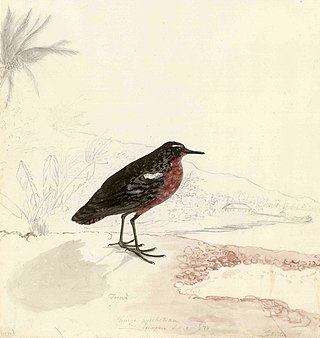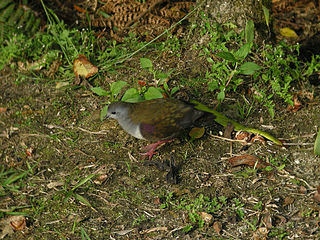
The Tahiti sandpiper or Tahitian Sandpiper is an extinct member of the large wader family Scolopacidae that was endemic to Tahiti in French Polynesia until its extinction sometime before 1819.

The Choiseul pigeon is an extinct species of bird in the pigeon and dove family, Columbidae. It was endemic to the island of Choiseul in the Solomon Islands, although there are unsubstantiated reports that it may once have lived on several nearby islands. The last confirmed sighting was in 1904. Other common names were Solomons crested pigeon, Solomon Islands crowned-pigeon and Kuvojo.

Gallicolumba is a mid-sized genus of ground-dwelling doves which occur in rainforests on the Philippines. Local name 'punay' which is a general term for pigeons and doves. They are not closely related to the American ground doves genus. Rather, the present genus is closest to the thick-billed ground pigeon.
The thick-billed ground dove is an extinct dove species of the family Columbidae.

The Tahiti rail, Tahitian red-billed rail, or Pacific red-billed rail is an extinct species of rail that lived on Tahiti. It was first recorded during James Cook's second voyage around the world (1772–1775), on which it was illustrated by Georg Forster and described by Johann Reinhold Forster. No specimens have been preserved. As well as the documentation by the Forsters, there have been claims that the bird also existed on the nearby island of Mehetia. The Tahiti rail appears to have been closely related to, and perhaps derived from, the buff-banded rail, and has also been historically confused with the Tongan subspecies of that bird.

The white-throated ground dove is a species of ground dove in the genus Gallicolumba. It is classified as near-threatened.

The bronze ground dove is a species of bird in the family Columbidae.

The Polynesian ground dove or Society Islands ground dove or Tutururu is a critically endangered species of bird in the family Columbidae. Originally endemic to the Society Islands and Tuamotus in French Polynesia, it has now been extirpated from most of its former range by habitat loss and predation by introduced species such as cats and rats, and the species is now endemic only in the Acteon islands. The total population is estimated to be around 100-120 birds.
The Wetar ground dove is a species of bird in the family Columbidae found on Wetar, Indonesia, and on Timor. Its natural habitats are monsoon forests and gallery forests, and possibly woodland and bamboos. Threatened by habitat loss and hunting, the species is assessed as endangered by the IUCN.

The white-breasted ground dove, white-bibbed ground dove, or purple ground dove is a species of bird in the family Columbidae. It is found in New Guinea, the Bismarck Archipelago and the Solomon Islands. Its natural habitats are subtropical or tropical moist lowland forest and subtropical or tropical moist montane forest.

The white-fronted ground dove or Caroline Islands ground dove is a species of bird in the family Columbidae. It is endemic to Micronesia.

The Norfolk ground dove was a species of bird in the Columbidae, or pigeon family.
The Marquesan ground dove or Marquesas ground dove is a bird species in the family Columbidae. It is endemic to French Polynesia. Its natural habitats are subtropical or tropical dry forests and subtropical or tropical moist shrubland.
The Santa Cruz ground dove is a species of bird in the family Columbidae. It is found in the southern Solomon Islands and Vanuatu. Its natural habitat is subtropical or tropical moist lowland forests. It is threatened by habitat loss.

The Tongan ground dove, also known as the shy ground dove or friendly ground dove, is a species of bird in the family Columbidae. It is found in American Samoa, Fiji, Samoa, Tonga and Wallis and Futuna Islands. Its natural habitat is subtropical or tropical moist lowland forests. It is threatened by habitat loss.

The thick-billed green pigeon is a species of bird in the family Columbidae.

The spotted green pigeon or Liverpool pigeon is a species of pigeon which is most likely extinct. It was first mentioned and described in 1783 by John Latham, who had seen two specimens of unknown provenance and a drawing depicting the bird. The taxonomic relationships of the bird were long obscure, and early writers suggested many different possibilities, though the idea that it was related to the Nicobar pigeon prevailed, and it was therefore placed in the same genus, Caloenas. Today, the species is only known from a specimen kept in World Museum, Liverpool. Overlooked for much of the 20th century, it was recognised as a valid extinct species by the IUCN Red List only in 2008. It may have been native to an island somewhere in the South Pacific Ocean or the Indian Ocean, and it has been suggested that a bird referred to as titi by Tahitian islanders was this bird. In 2014, a genetic study confirmed it as a distinct species related to the Nicobar pigeon, and showed that the two were the closest relatives of the extinct dodo and Rodrigues solitaire.

The Raiatea starling, formerly known as the bay thrush, bay starling, or the mysterious bird of Ulieta, is an extinct bird species of uncertain taxonomic relationships that once lived on the island of Raiatea, the second largest of the Society Islands in French Polynesia.

Pampusana is a mid-sized genus of ground-dwelling doves which occur in rainforests in the Pacific region. They are not closely related to the American ground doves.















